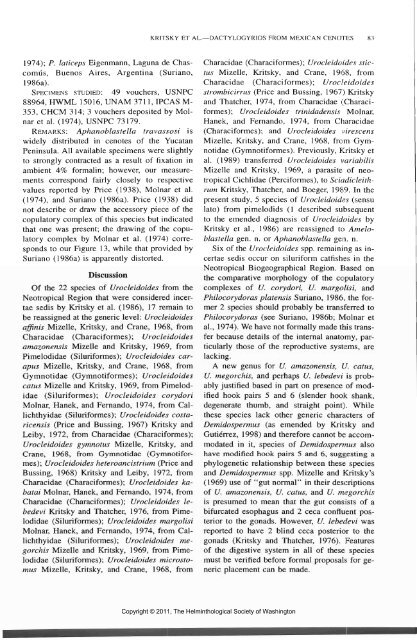Comparative Parasitology 67(1) 2000 - Peru State College
Comparative Parasitology 67(1) 2000 - Peru State College
Comparative Parasitology 67(1) 2000 - Peru State College
Create successful ePaper yourself
Turn your PDF publications into a flip-book with our unique Google optimized e-Paper software.
1974); P. laticeps Eigenmann, Laguna de Chascomus,<br />
Buenos Aires, Argentina (Suriano,<br />
1986a).<br />
SPECIMENS STUDIED: 49 vouchers, USNPC<br />
88964, HWML 15016, UN AM 3711, IPCAS M-<br />
353, CHCM 314; 3 vouchers deposited by Molnar<br />
et al. (1974), USNPC 73179.<br />
REMARKS: Aphanoblastella travassosi is<br />
widely distributed in cenotes of the Yucatan<br />
Peninsula. All available specimens were slightly<br />
to strongly contracted as a result of fixation in<br />
ambient 4% formalin; however, our measurements<br />
correspond fairly closely to respective<br />
values reported by Price (1938), Molnar et al.<br />
(1974), and Suriano (1986a). Price (1938) did<br />
not describe or draw the accessory piece of the<br />
copulatory complex of this species but indicated<br />
that one was present; the drawing of the copulatory<br />
complex by Molnar et al. (1974) corresponds<br />
to our Figure 13, while that provided by<br />
Suriano (1986a) is apparently distorted.<br />
Discussion<br />
Of the 22 species of Urocleidoides from the<br />
Neotropical Region that were considered incertae<br />
sedis by Kritsky et al. (1986), 17 remain to<br />
be reassigned at the generic level: Urocleidoides<br />
affinis Mizelle, Kritsky, and Crane, 1968, from<br />
Characidae (Characiformes); Urocleidoides<br />
amazonensis Mizelle and Kritsky, 1969, from<br />
Pimelodidae (Siluriformes); Urocleidoides carapus<br />
Mizelle, Kritsky, and Crane, 1968, from<br />
Gymnotidae (Gymnotiformes); Urocleidoides<br />
catus Mizelle and Kritsky, 1969, from Pimelodidae<br />
(Siluriformes); Urocleidoides corydori<br />
Molnar, Hanek, and Fernando, 1974, from Callichthyidae<br />
(Siluriformes); Urocleidoides costaricensis<br />
(Price and Bussing, 19<strong>67</strong>) Kritsky and<br />
Leiby, 1972, from Characidae (Characiformes);<br />
Urocleidoides gymnotus Mizelle, Kritsky, and<br />
Crane, 1968, from Gymnotidae (Gymnotiformes);<br />
Urocleidoides heteroancistrium (Price and<br />
Bussing, 1968) Kritsky and Leiby, 1972, from<br />
Characidae (Characiformes); Urocleidoides kabatai<br />
Molnar, Hanek, and Fernando, 1974, from<br />
Characidae (Characiformes); Urocleidoides lebedevi<br />
Kritsky and Thatcher, 1976, from Pimelodidae<br />
(Siluriformes); Urocleidoides margolisi<br />
Molnar, Hanek, and Fernando, 1974, from Callichthyidae<br />
(Siluriformes); Urocleidoides megorchis<br />
Mizelle and Kritsky, 1969, from Pimelodidae<br />
(Siluriformes); Urocleidoides microstomus<br />
Mizelle, Kritsky, and Crane, 1968, from<br />
KRITSKY ET AL.—DACTYLOGYRIDS FROM MEXICAN CENOTES<br />
Characidae (Characiformes); Urocleidoides stictus<br />
Mizelle, Kritsky, and Crane, 1968, from<br />
Characidae (Characiformes); Urocleidoides<br />
strombicirrus (Price and Bussing, 19<strong>67</strong>) Kritsky<br />
and Thatcher, 1974, from Characidae (Characiformes);<br />
Urocleidoides trinidadensis Molnar,<br />
Hanek, and Fernando, 1974, from Characidae<br />
(Characiformes); and Urocleidoides virescens<br />
Mizelle, Kritsky, and Crane, 1968, from Gymnotidae<br />
(Gymnotiformes). Previously, Kritsky et<br />
al. (1989) transferred Urocleidoides variabilis<br />
Mizelle and Kritsky, 1969, a parasite of neotropical<br />
Cichlidae (Perciformes), to Sciadicleithrum<br />
Kritsky, Thatcher, and Boeger, 1989. In the<br />
present study, 5 species of Urocleidoides (sensu<br />
lato) from pimelodids (1 described subsequent<br />
to the emended diagnosis of Urocleidoides by<br />
Kritsky et al., 1986) are reassigned to Ameloblastella<br />
gen. n. or Aphanoblastella gen. n.<br />
Six of the Urocleidoides spp. remaining as incertae<br />
sedis occur on siluriform catfishes in the<br />
Neotropical Biogeographical Region. Based on<br />
the comparative morphology of the copulatory<br />
complexes of U. corydori, U. margolisi, and<br />
Philocorydoras platensis Suriano, 1986, the former<br />
2 species should probably be transferred to<br />
Philocorydoras (see Suriano, 1986b; Molnar et<br />
al., 1974). We have not formally made this transfer<br />
because details of the internal anatomy, particularly<br />
those of the reproductive systems, are<br />
lacking.<br />
A new genus for U. amazonensis, U. catus,<br />
U. megorchis, and perhaps U. lebedevi is probably<br />
justified based in part on presence of modified<br />
hook pairs 5 and 6 (slender hook shank,<br />
degenerate thumb, and straight point). While<br />
these species lack other generic characters of<br />
Demidospermus (as emended by Kritsky and<br />
Gutierrez, 1998) and therefore cannot be accommodated<br />
in it, species of Demidospermus also<br />
have modified hook pairs 5 and 6, suggesting a<br />
phylogenetic relationship between these species<br />
and Demidospermus spp. Mizelle and Kritsky's<br />
(1969) use of "gut normal" in their descriptions<br />
of U. amazonensis, U. catus, and U. megorchis<br />
is presumed to mean that the gut consists of a<br />
bifurcated esophagus and 2 ceca confluent posterior<br />
to the gonads. However, U. lebedevi was<br />
reported to have 2 blind ceca posterior to the<br />
gonads (Kritsky and Thatcher, 1976). Features<br />
of the digestive system in all of these species<br />
must be verified before formal proposals for generic<br />
placement can be made.<br />
Copyright © 2011, The Helminthological Society of Washington
















